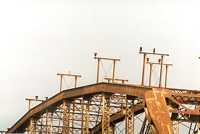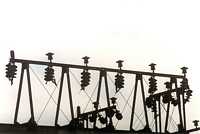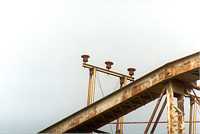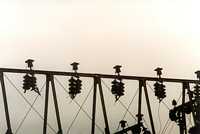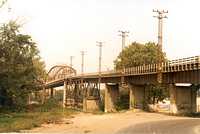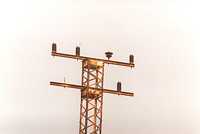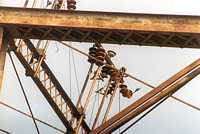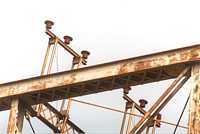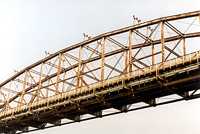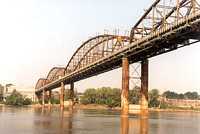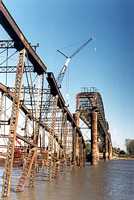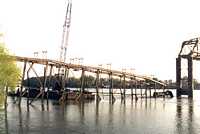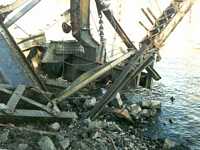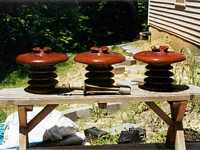M-2942 - Pat Scott's Story
Insulators Home >
Insulator Styles > Porcelain
Multiparts > M-2942 > Pat Scott's Story
Story and Photos provided by Pat Scott; originally written in April 2000
Wrapping insulators to ship can be tedious at times, so I usually find myself
breaking the monotony by reading stories or cartoons when something interesting
catches my eye on one of the newspapers with which I am wrapping. One particular
day, a photograph caught my eye. It was a photo of the Hwy. 115 bridge in St.
Charles, MO, and the accompanying article talked of its planned demise. A contractor
was hired to demolish this old structure, which at the time in 1997 had seen
4 years pass since the last automobile traversed the Missouri River on its rickety
deck. I knew it would be torn down sometime, but would it be a year, 10 years,
50 years?
Well, I'd had my eye on that bridge for a good number of years before I saw
the article, because atop it was a 3-phase 34.5 kV Union Electric line, insulated
with some funny-looking porcelain multipart insulators. Obviously, these insulators
were out of the question. It is generally not wise to touch a 34.5 KV line--
that is, unless you are trying to put on your own personal fireworks display,
with you as the centerpiece. I'm not into that. I had not visited the bridge
in a long while, so I thought it would be a good idea to drive by, just to see
what was going on.
Upon my arrival, I noticed that the wires had been pulled from the bridge and
all those insulators were still atop the bridge. Wow, and they were neat-looking,
too. I still could find no photo of them to tell me what they were.
A few months later, the article for which I was waiting appeared in the paper.
This article told of the planned timetable of demolition, and gave the name
of the company responsible for the job. When the day finally came for the first
of 4 sections to be blown up, I was there. After waiting for the dust to settle,
so to speak, I drove around, asked around, and finally found the individual
who was overseeing the whole job. I inquired as to what the fate of this porcelain
would be, knowing that this company was not interested in salvaging it. He promised
he could save me one, but you know how those promises go most of the time. I
had just found out that morning that these were Lapps, because a few of them
from the bridge made landfall, which of course was not a very pretty sight.
There was one broken piece that said Lapp. There were also 12 sets of Ohio Brass
suspensions on this part of the bridge, but only one disk out of the 48 survived.
I figured I'd take that later in the evening when the workers left. I did not
have a Lapp yet, so I wanted some kind of insulator souvenir from the bridge
in case the Lapp never came my way. I did make it back that evening, but broke
the damn suspension while taking it off its bracket. What a numbskull. One of
48 survived, then I break it taking it off! That was Murphy's Law.
Anyway, a couple of days later, I found the foreman again, and sure as heck,
he did save me one. He took me to the shed in which it was stored, and I then
found out that he had saved all of them. I asked about another, and he told
me not to get greedy, he promised he would save one for me, and one was all
I was getting. Hmmm.
The next week, I got an idea. For one, I had called Rick Soller to see what
these were. They were listed in the porcelain price guide, but had no picture.
It was the Lapp M-2942, and I learned that the only place these were known to
exist was this bridge. With that, I decided there was no way I could let those
others go. I wanted to preserve as many as possible so that others could enjoy
them, and I just couldn't fathom the idea of them all being trashed. It was
up to me, and I had to come through. I went back and found the foreman again,
and knowing that he was seeing dollar signs in these, I asked if I could buy
them instead. He said he would think about it, for me to shoot him a price,
and he would call me back. We finally arrived at a price, and I bought 12 of
them. A lot of the ones in the shed were cracked, so I left those, and there
were still some on the remaining 2 sections of the bridge. I called Rick back
to see if he wanted one, and from there I was told to call a few people that
would probably be interested. Soon, I guess word got out, and people started
calling me.
Those 12 were quickly gone, so two weeks later when the last half of the bridge
came down, I bought 10 more. This time, I also left the cracked ones, but noticed
that 2 of them were different. All of the others so far had LAPP inkstamp markings.
These 2 had an incuse mark with the 1926 code on the Lapp symbol. All others
said 1927. Though both were cracked, I thought I'd better get them, because
they were the only two out of all of them that came down. I had 10 more to get
rid of, but again, they sold themselves. I had a few people who were already
on the list, and the remaining ones soon sold and traded at shows.
That is what I call success. After all, I was able to preserve a group of insulators
that would have otherwise been destroyed. Now there are many multipart and Lapp
collectors who have a nice piece in their collection. I know of two people who
swear by these as being their favorite insulators. It's certainly one of mine.
Heck, for that matter, that foreman probably bought himself a hefty Christmas
present that year with the price that I had to pay him for all 23 insulators.
My only regret about the whole experience was that at one point, I had about
15 of them on a white blanket in the basement, and I should have taken a photo
of the one and only time they were all in one place. Oh well, at least I know
they all went to good homes.
Be persistant, ask around, and be prepared to pay, do favors, or buy beer in
return. Persistance like this is a great way to ensure that good insulators
make their way to where they belong... in the hobby, not at the bottom of a
landfill or holding up someone's derelict vehicle in their front yard. If you
know where something good is, check up on it, and if you ever see it coming
down, do what you can to get it.
Story and Photos provided by Pat Scott; originally written in April 2000
Insulators Home >
Insulator Styles > Porcelain
> Multiparts >
M-2942 > Pat Scott's Story
Contact: A.C. Walker
